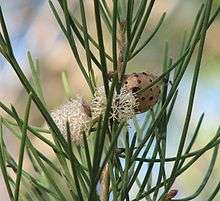Hakea drupacea
| Sweet hakea | |
|---|---|
 | |
| Scientific classification | |
| Kingdom: | Plantae |
| (unranked): | Angiosperms |
| (unranked): | Eudicots |
| Order: | Proteales |
| Family: | Proteaceae |
| Genus: | Hakea |
| Species: | H. drupacea |
| Binomial name | |
| Hakea drupacea (C.F.Gaertn.) Roem. & Schult.[1] | |
Hakea drupacea, commonly known as sweet hakea, is a tree or shrub which is native to south west Western Australia.
Description
Sweet hakea is erect in habit, growing to between 1 and 4 metres tall. It has white flowers which appear between early autumn and early winter (March to June in Australia). These are followed by woody seed capsules that are 20 to 25 mm long and 15 to 19 mm wide.[2]
Taxonomy
The species was first described by Karl Friedrich von Gaertner in 1807, and given the name Conchium drupaceum. It was also formerly known as Hakea suaveolens.[1]
Distribution
The species occurs in Western Australia - mainly as a coastal species - between Albany and east of Cape Arid - and on the Recherche Archipelago Islands.[3] The species is naturalised in South Africa (where it is known as soethakea, meaning "sweet hakea") and New Zealand.[4]
References
- 1 2 "Hakea drupacea (C.F.Gaertn.) Roem. & Schult.". Australian Plant Name Index (APNI), IBIS database. Centre for Plant Biodiversity Research, Australian Government.
- ↑ "Hakea drupacea". FloraBase. Western Australian Government Department of Parks and Wildlife.
- ↑ Ivan Holliday (2005). "Hakeas : a field and garden guide". Sydney: Reed New Holland. ISBN 978-1-877069-14-7.
- ↑ "Taxon: Hakea drupacea (C. F. Gaertn.) Roem. & Schult.". Germplasm Resources Information Network (GRIN). United States Department of Agriculture, Agricultural Research Service, Beltsville Area. Retrieved 25 September 2011.